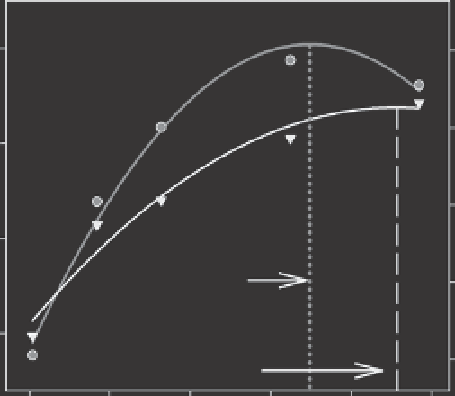Agriculture Reference
In-Depth Information
As a result, research has focused on improving
nutrient application efficiency (Westermann
et al
.,
1988; Waddell
et al
., 2000; Davenport
et al
.,
2005). Excessive soil nutrients, especially nitrogen,
may promote a source-sink imbalance, which
can delay tuber initiation, plant maturity and
tuber bulking, and promote excessive foliage
growth at the expense of tuber yield.
An important concept to remember when
applying fertilizers is that maximum biological
yield does not always result in maximum eco-
Figure 6.3
demonstrates this principle with
the potato variety Alturas, grown at different rates
of full-season N in the Columbia Basin of Wash-
ington during 2009-2011. The maximum bio-
logical yield of 86.3 t ha
-
1
was realized with 485 kg
N ha
-
1
;
however, the maximum economic return
of US$
12,042
ha
-
1
came from a yield of
85
t ha
-
1
,
which was produced with only 410 kg N ha
-
1
.
Moreover, the economic return from potatoes pro-
duced with 333 kg N ha
-
1
was identical to that of
potatoes produced with 485 kg N ha
-
1
(US$11,720
increased the yield from
83
to 86.3 t ha
-
1
,
the
expense of the additional nitrogen offset any eco-
nomic gain that would have come from the extra
3.3 t ha
-
1
of yield.
Based on data from Kolbe and Stephan-
Beckmann (1997b), whole potato plants may
remove 3.6, 0.7, and 6.4 kg N, P
2
O
5
, and K
2
O,
respectively, from the soil per tonne of fresh
plant and tuber weight. Considering those values,
fresh-weight yields exceeding
79
t ha
-
1
,
similar to
those found in the Columbia Basin of Wash-
ington State may extract more than
286,
56,
and
509 kg ha
-
1
of N, P
2
O
5
, and K
2
O, respectively, from
the soil during one growing season (Kolbe and
Stephan-Beckmann, 1997b). In contrast, a
1980 study by Dow and Cline calculated that a
79
t ha
-
1
yield would remove 422,
47,
and 520 kg
ha
-
1
of N, P
2
O
5
, and K
2
O, respectively (Dow and
Cline, 1980). Presumably, the differences be-
tween the two studies were due to growing en-
vironment and variety differences.
To achieve a
79
t ha
-
1
tuber yield for Russet
Burbank grown for approximately 150 days in
the Columbia Basin of Washington State, re-
searchers recommend depleted soils receive ap-
proximately 391,
330,
and 537 kg ha
-
1
of N,
P
2
O
5
, and K
2
O fertilizer, respectively (Lang
et al
.,
1999). Alternatively, growers in shorter-season
regions like the UK may need to apply rates of
270,
250,
and 360 kg ha
-
1
of N, P
2
O
5
, and K
2
O,
respectively, for Russet Burbank when grown for
120 days (Dampney
et al
., 2013). It is interesting
Adjusted
gross
return
12000
90
To tal
yield
85
11000
80
Maximum economic
return produced with
410 kg N ha
-
1
10000
75
Maximum yield
produced with
485 kg N ha
-
1
9000
70
165
235 305
To tal season nitrogen (kg ha
-1
)
375
445
515
Fig. 6.3.
Alturas total yield (
R
2
= 0.96) and nitrogen-cost adjusted gross return (
R
2
= 0.99) when grown
with five total season nitrogen rates (
168,
224,
280,
392, and 504 kg ha
-1
) in the Columbia Basin of
Washington, USA, 2009-2011. Maximum economic return of US$
12,042
ha
-
1
(gray dotted line) came from
potatoes produced with 410 kg N ha
-
1
,
while the maximum biological yield (black dashed line) of 86.3 t
ha
-
1
was produced with 485 kg N ha
-
1
.
(Unpublished data from M.J. Pavek.)

